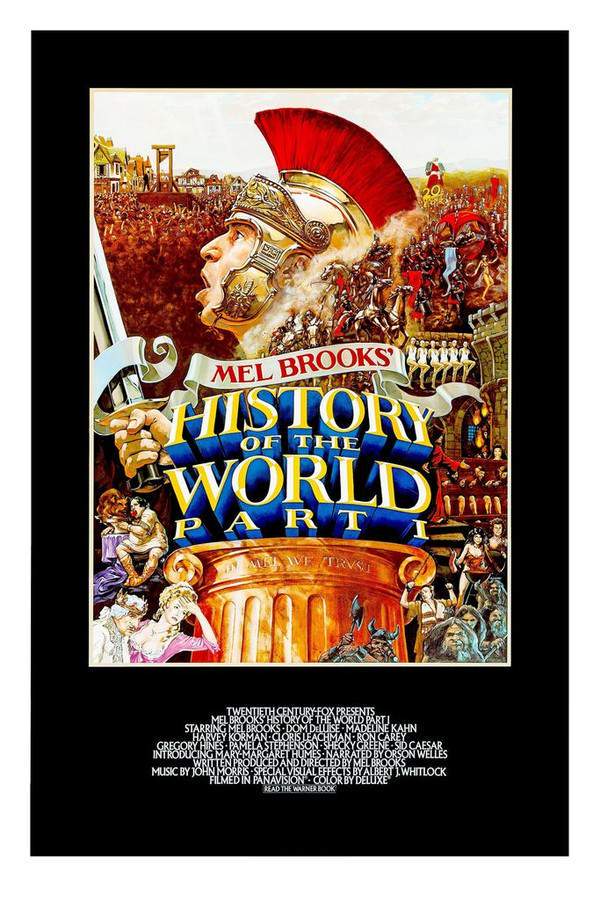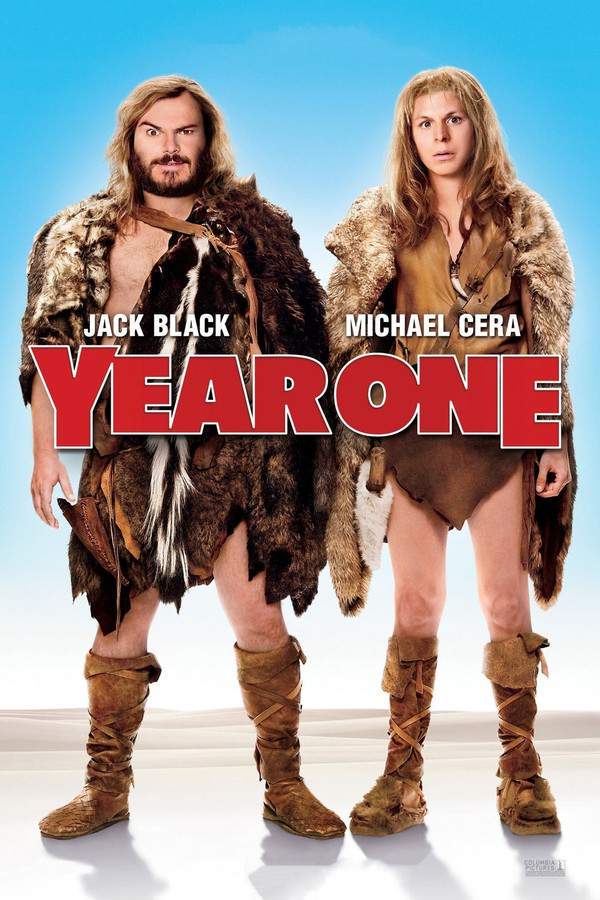
History of the World: Part I 1981
Made by

Twentieth Century Fox
Test your knowledge of History of the World: Part I with our quiz!
History of the World: Part I Plot Summary
Read the complete plot summary and ending explained for History of the World: Part I (1981). From turning points to emotional moments, uncover what really happened and why it matters.
In this uproarious spoof of legendary films, History of the World, Part I takes the audience on a comedic journey across four distinct historical eras, each marked by whimsical and irreverent sketches. The adventure kicks off in the Stone Age, where early humans, including the incomparable Sid Caesar, spark remarkable inventions like fire, art, music, and even early forms of humor and critique. Witness the dawn of civilization unfold through their rudimentary weapons, marriage customs, and the world’s first funeral rites.
The action then catapults into ancient Egypt, where Moses, portrayed by Mel Brooks, returns from a divine meeting on Mount Sinai intent on sharing the Law. In a moment of excitement, he accidentally drops one of the stone tablets, leading to a rapid revision from 15 Commandments to the now-familiar 10.
Next, we meet Comicus, also played by Mel Brooks, a philosopher turned stand-up comic who is called upon by his flamboyant agent, Ron Carey, to perform at the grand Caesar’s palace. During his journey, he encounters Miriam (Mary-Margaret Humes), a captivating Vestal Virgin who captures his heart, along with Josephus, portrayed by Gregory Hines, an Ethiopian slave who quickly becomes his loyal companion.
As Comicus grapples with the intricacies of Roman politics, he finds himself amid the pompous Emperor Nero, humorously embodied by Dom DeLuise. Nero’s inflated ego and corrupt nature offer endless comedic material. However, when Josephus mistakenly prompts an order for them to engage in a life-and-death gladiatorial bout, the two must rely on their wit and cleverness to escape the palace’s grasp, dodging the menacing Marcus Vindictus, played by Shecky Greene, and his soldiers.
Seeking sanctuary, the trio takes refuge in the palace of Empress Nympho, portrayed by Madeline Kahn, disguising themselves as eunuch guards. Yet, their cover is nearly blown when Josephus’s apparent desire gives away their identities, leading to an uproarious chase through the palace. They finally make their break aboard a horse-drawn cart, obscured by the haze of an enormous marijuana joint that leaves their pursuers in a state of bewildered stupor.
As Comicus navigates the turbulent landscape of Judea, he inadvertently stumbles upon a gathering that includes Jesus (John Hurt) and his disciples during their intimate dinner party. The clumsy waiter, with his frequent interruptions and unintended humor, disrupts the solemnity of the Last Supper, all while Leonardo da Vinci (Art Metrano) strives to creatively capture the scene for posterity.
In a dazzling sequence that parodies classic Busby Berkeley choreography, Mel Brooks takes the stage as Torquemada, presenting a lavish song-and-dance routine that defies all conventions of good taste. The sequence kicks off with a herald announcing the infamous inquisitor, while the condemned plead for clemency: > “you can’t Torquemada anything.” The comedic mayhem follows with a series of absurd tortures, including a spinning iron maiden and nuns performing water ballet in an Esther Williams-inspired spectacle. Hilarious cameos from Jackie Mason and Ronny Graham further enrich the scene, as they portray Jewish characters facing absurd tortures.
Transitioning to a Parisian tavern, Madame Defarge, played by Cloris Leachman, stirs the pot of rebellion, rallying others to drive the French Revolution. Meanwhile, King Louis, again embodied by Mel Brooks, remains blissfully unaware of the peasants’ perceptions despite the warnings from his advisers, Count de Monet (played by Harvey Korman) and Béarnaise (Andreas Voutsinas). His obliviousness is made sharper by his absurd pleasure of using peasants as targets in a skeet shooting game. The lovely Mademoiselle Rimbaud, portrayed by Pamela Stephenson, approaches King Louis to plead for the release of her father, who has languished in the Bastille for a decade. In exchange for her request, the king demands a romantic rendezvous that evening.
With the help of Count de Monet, the king goes into hiding, and a look-alike named Jacques is picked as his decoy, notably portrayed by Mel Brooks, who is usually found holding buckets for the aristocrats. That fateful night, Mademoiselle Rimbaud arrives at “King” Jacques’s chambers, unaware that he is not the real monarch. To her surprise, he grants her father’s freedom without the expected romantic strings attached.
Just as the peasants burst in to arrest Jacques, taking him off to the guillotine, Rimbaud exclaims in distress that “only a miracle can save him,” when, just then, Josephus arrives in a cart drawn by a miraculous force, leading to their daring escape headed towards a mountain marked with the words “THE END.”
As the story draws to a close, Mel Brooks humorously introduces an imaginary trailer for his anticipated sequel, History of the World, Part II. This teaser is a whirlwind of absurdity and humor, showcasing ridiculous scenes from segments like “Hitler on Ice,” where the infamous dictator trades his military attire for ice skates; “A Viking Funeral,” a raucous send-off that flouts all conventions; and “Jews in Space,” a comical twist placing Jewish characters in a galaxy inspired by Star Wars.
History of the World: Part I Timeline
Follow the complete movie timeline of History of the World: Part I (1981) with every major event in chronological order. Great for understanding complex plots and story progression.
Inventions in the Stone Age
The adventure begins in the Stone Age, where early humans, including the comedic genius Sid Caesar, are seen making groundbreaking inventions. They ignite fire, create art, and develop music, laying the foundation for humor and critique within their society.
Moses and the Tablets
In ancient Egypt, Moses, played by Mel Brooks, returns from Mount Sinai eager to share divine laws with the people. However, in an amusing turn of events, he accidentally drops one of the tablets, humorously revising the 15 Commandments down to 10.
Comicus's Rise
Comicus, another role by Mel Brooks, embarks on a journey as a philosopher-turned-stand-up comic, called upon by his flamboyant agent, Ron Carey. This marks the beginning of his comedic adventures in the heart of Roman society.
Encountering Miriam and Josephus
During his travels, Comicus meets Miriam, a captivating Vestal Virgin, and Josephus, an Ethiopian slave portrayed by Gregory Hines. This trio’s dynamic becomes pivotal as they maneuver through the complexities of their era's politics.
Schemes of Emperor Nero
Comicus and Josephus find themselves entangled with the pompous Emperor Nero, humorously brought to life by Dom DeLuise. The situation escalates when they face a comedic death sentence due to a misunderstanding involving gladiatorial combat.
Hide and Seek in the Palace
To evade capture, the trio disguises themselves as eunuch guards in Empress Nympho's palace. Their cover is hilariously almost blown when Josephus's behavior raises eyebrows, leading to a wild chase.
The Great Escape
In a frantic bid for freedom, Comicus, Josephus, and Miriam flee in a horse-drawn cart concealed by the smoke of a massive marijuana joint. This absurdity causes their pursuers to become completely disoriented and confused.
Clumsy Service at the Last Supper
Comicus stumbles into the Last Supper, interrupting Jesus and his disciples with his comical service blunders. His antics disrupt the solemn dinner, much to the chagrin of Leonardo da Vinci, who attempts to capture the moment artistically.
Torquemada’s Musical Extravaganza
In a lavish and absurd number, Mel Brooks plays Torquemada, showcasing a theatrical routine that parodies historical inquisition. The scene features nuns performing water ballet, twisting traditional concepts through comedy.
Madame Defarge and the French Revolution
In a Parisian tavern, Madame Defarge ignites a revolutionary fervor among the people. King Louis, oblivious to the brewing rebellion, enjoys ludicrous pastimes while his advisers attempt to warn him of the impending uproar.
The King's Deception
To escape the chaos, King Louis seeks refuge by using a look-alike as a decoy. Unaware, Mademoiselle Rimbaud arrives at the decoy's chambers, leading to a humorous encounter filled with unexpected twists and liberation.
Race Against Time
As peasants storm the palace to seize the decoy, Rimbaud's panic crescendos into a plea for a miracle. In a twist of fate, Josephus arrives just in time in a cart, allowing their daring escape amidst chaos.
The Closing Scene
The adventure wraps up with Mel Brooks introducing a hilarious imaginary trailer for a sequel. This teaser presents a series of ludicrous upcoming sketches including 'Hitler on Ice' and 'Jews in Space', leaving audiences in stitches.
History of the World: Part I Characters
Explore all characters from History of the World: Part I (1981). Get detailed profiles with their roles, arcs, and key relationships explained.
Moses (Mel Brooks)
Moses is a comically exaggerated figure, caught in a humorous predicament as he accidentally alters the commandments. His character embodies the clash between divine authority and human error, delivering comedic revelations during critical moments. He represents both leadership and folly in a light-hearted retelling of biblical events.
Comicus (Mel Brooks)
Comicus is a philosophical comedian navigating the absurdities of Roman life. As a clever and witty character, he reflects the struggle of an artist trying to find his place within a rigid system, using humor as his shield. His encounters highlight the collision of intellect and jest in a politically charged environment.
Emperor Nero (Dom DeLuise)
Nero is portrayed as an over-the-top, egotistical ruler whose pompous nature leads to comedic misadventures. His inflated sense of self and detachment from reality provide a richly humorous critique of power and corruption in ancient Rome. He exemplifies the excess and folly of leadership in a vibrant historical parody.
Josephus (Gregory Hines)
Josephus is a loyal companion and comedic foil to Comicus, navigating the challenges of Roman culture as an Ethiopian slave. His character brings a unique energy and perspective, often blending cleverness with comedic mishaps. His comedic relief is essential as he helps highlight the absurdities occurring around him.
Empress Nympho (Madeline Kahn)
Empress Nympho is a flamboyant character whose presence adds an additional layer of humor to the political chaos. Her captivating and bold personality creates witty exchanges, enhancing the comedic elements of the plot. She plays a crucial role in the farcical antics surrounding palace intrigue.
History of the World: Part I Settings
Learn where and when History of the World: Part I (1981) takes place. Explore the film’s settings, era, and how they shape the narrative.
Time period
Various historical eras
The movie traverses multiple historical eras, starting from the primitive Stone Age to the ancient complexities of Egypt and Judea, ultimately landing in revolutionary Paris. Each segment plays with historical events, reimagining them through a comedic lens, thus blending humor with varied timelines. This variety showcases the evolution of culture and societal norms across ages.
Location
Stone Age, Ancient Egypt, Judea, Paris
The Stone Age is depicted with early humans inventing fundamental aspects of civilization, such as fire and art, marking the dawn of mankind. Ancient Egypt serves as a backdrop for significant religious narratives, particularly the comedic reinterpretation of Moses's encounter with divine laws. Judea is humorously illustrated during an intimate dinner of Jesus and his disciples, blending reverence with absurdity. Paris is the setting for the brewing French Revolution, characterized by a tavern scene rich in cultural upheaval and comedic rebellion.
History of the World: Part I Themes
Discover the main themes in History of the World: Part I (1981). Analyze the deeper meanings, emotional layers, and social commentary behind the film.
😂
Comedy
The overarching theme of comedy is prevalent throughout as historical events are portrayed in a humorous and satirical manner. From the absurd errors of Moses to the playful mockery of Roman politics, the film uses humor to challenge conventional narratives. It cleverly intertwines brand new comedic scenarios with well-known historical tales, creating a unique blend of laughter and learning.
🕰️
History
This film creatively engages with historical events, exploring key moments from the Stone Age to the French Revolution. By re-contextualizing these eras with humor and wit, it invites the audience to reflect on the absurdities of human history. It showcases various cultural milestones, urging viewers to see the lighter side of our past.

Coming soon on iOS and Android
The Plot Explained Mobile App
From blockbusters to hidden gems — dive into movie stories anytime, anywhere. Save your favorites, discover plots faster, and never miss a twist again.
Sign up to be the first to know when we launch. Your email stays private — always.
History of the World: Part I Spoiler-Free Summary
Discover the spoiler-free summary of History of the World: Part I (1981). Get a concise overview without any spoilers.
In a wildly imaginative romp that treats the past like a grand stage, the film sweeps viewers from the first flicker of fire to the height of medieval intrigue, stitching together a series of comic sketches that parody humanity’s most iconic moments. Each segment leans into the absurdity of history, turning revered legends into playgrounds for jokes, song, and slap‑stick, while the overarching premise remains a playful tour through time‑tossed vignettes.
The ensemble is led by a cast of comedy legends who bring their own brand of manic energy to the tableau. Sid Caesar stars as a primal ancestor whose unrefined antics set the tone for the entire adventure, while Mel Brooks pops up in a succession of larger‑than‑life personas, from a flamboyant prophet to a scheming ruler, each delivered with his signature blend of wit and musical flair. Dom DeLuise adds a bombastic presence that underscores the film’s relentless giddiness, and Madeline Kahn injects razor‑sharp timing into the chaotic courtly scenes. Even John Hurt appears in a brief, reverent cameo that juxtaposes solemnity with the surrounding farce.
At the heart of the whirlwind is a charismatic performer—a self‑aware comic who drifts from era to era, adopting the trappings of each epoch while retaining a modern sensibility. This character’s interactions with a revolving cast of exaggerated historical archetypes create a constant push‑and‑pull between reverence and ridicule, allowing the film to explore how the grand narratives we inherit can be both celebrated and subverted. Their chemistry fuels the relentless pacing, making each transition feel like a fresh punchline waiting to land.
The tone is unabashedly irreverent, marrying big‑budget choreography with low‑brow humor, and peppered with musical numbers that erupt in joyous, anachronistic spectacle. The world feels simultaneously familiar and wildly distorted, inviting audiences to laugh at the absurdity of “the story we think we know.” It’s a celebration of comedy’s power to rewrite history—one ridiculous sketch at a time.
Can’t find your movie? Request a summary here.
Movies with Similar Twists and Themes
Uncover films that echo the narrative beats, emotional arcs, or dramatic twists of the one you're exploring. These recommendations are handpicked based on story depth, thematic resonance, and spoiler-worthy moments — perfect for fans who crave more of the same intrigue.
Featured on this page

What's After the Movie?
Not sure whether to stay after the credits? Find out!
Explore Our Movie Platform
New Movie Releases (2025)
Famous Movie Actors
Top Film Production Studios
Movie Plot Summaries & Endings
Major Movie Awards & Winners
Best Concert Films & Music Documentaries
Movie Collections and Curated Lists
© 2025 What's After the Movie. All rights reserved.







